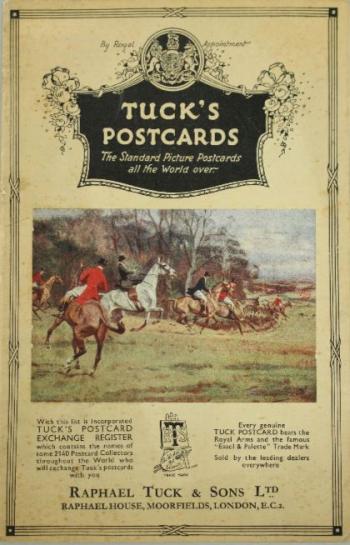Raphael Tuck
This sadly now defunct business began in 1866 in what was Union Street (now Brushfield Street), Bishopsgate, London when Tuck and his wife Ernestine, recently arrived from Prussia opened a small shop dealing in picture frames and a few modest pictures. Within a short time having contacted dealers and printmakers in Prussia, Tuck had begun to print and sell oleographs and chromolithographs and popular Victorian greetings cards. An orthodox Jewish Talmudic scholar, he was born in 1821 in Koschmin in the province of Poznan which is about 200 miles west of Warsaw. He fathered seven children, and three of his four boys helped their father grow the business. Adolph Tuck was the Managing Director of the Company until his death in 1926 having been raised to the Peerage in 1910. Raphael had been trained in Graphic Art and had an eye for unusual commercial art which he offered to an eager British public. Ironically, an orthodox Jew should have been the major promoter and proponent of Christmas cards! In 1880, by now well established and respected in their business dealings son Adolph launched a national competition for the best Christmas card design the first prize was £5,000. That sum today would be more than half a million pounds. All the 5000-plus entries were exhibited at the Dudley Gallery and professional artists and writers judged the winners. These competitions continued into the 20th century and proved a great commercial success. The Tuck empire continued to expand and they soon opened branches in Paris, Berlin, Montreal and New York, in 1883, Queen Victoria granted the firm the Royal Warrant of Appointment.
The number of cards Tuck ultimately issued to the market for each set varied greatly, presumably according to demand. The records show that many of the early numbered monochromatic cards were issued by Tuck at a minimum of 6000 at a time. Raphael Tuck died on March 16, 1900. He did not live to see the postcard blossom into the popular form of social communication that it became just a decade after his death. Adolph and his brothers in good Jewish tradition continued to expand the business after Raphael’s death. It was due to the efforts of Adolph Tuck that the size of the postcard in England was increased to the size allowed by the Universal Postal Union. Only a small picture and brief messages were allowed on one side with just an address and stamp on the other. After four years of negotiations, Adolph succeeded in convincing the British Postmaster General that a larger card could have a picture on one side and a brief message as well as the address and stamp on the other. In 1898, the Postmaster General finally agreed and a new era was begun. It is thought that more than 40,000 different picture postcards were printed and sold in many thousands of editions but sadly most of the records were lost when on the night of December 29th, 1940, enemy bombing destroyed the Tuck Offices now located in Tener Street, Moorfields. The Company restarted from the ashes and by the early 1960’s after the last Tuck family member had retired the firm had combined with others to become the British Printing Corporation.
Notable artists illustrating sets of Tuck cards included Percy Bradshaw, John Fulleylove, John Hassall, George Kilburne, Phil May, Marjorie Mostyn, Lance Thackeray, and Bert Thomas amongst many others.
Get Unlimited Access from just £5


